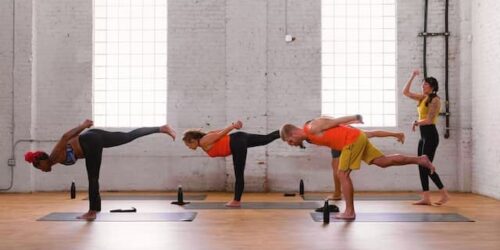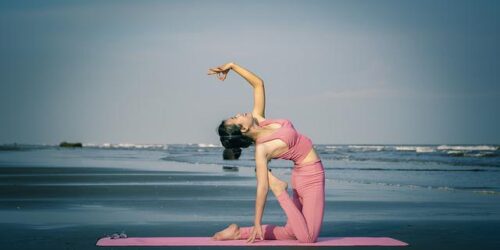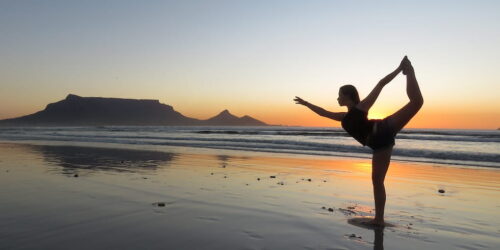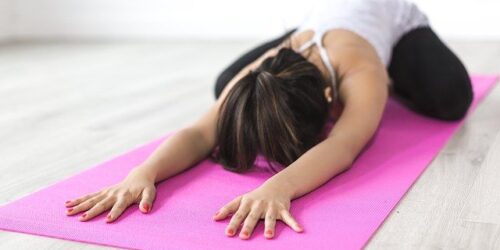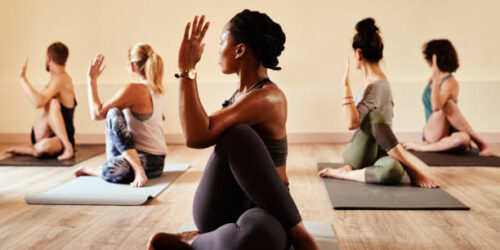Can You Do Yoga If You’re Not Flexible? What You Need To Know
First, can you do yoga if you’re not flexible? YES!
You absolutely can! Yoga is a practice for everybody, no matter your size, age, gender, or level of flexibility. It’s a common misconception that you have to be flexible in order to practice yoga. What makes you flexible is yoga! Your muscles will loosen, relax, and lengthen as a result of regular yoga practice, allowing you to move more freely and comfortably into the poses.
A little side note: yoga is so much more than just the physical practice or asana as it’s called in Sanskrit, and when we refer to flexibility, we are only talking about one small part of the entire yogic philosophy.
Please continue reading so I can give you more specific information.
Table of Contents
Ways To Practice Yoga If You’re Inflexible
As I mentioned earlier, yoga will help you gradually IMPROVE your flexibility, so you can practice it even if you’re not flexible. Here are a few things to take into account during your practice to make
Discover Baseline
Ask yourself first: “Do I suffer from any illnesses or injuries that restrict my range of motion?” Or perhaps you’ve simply lost some of your flexibility? If this is the case, look for a course that has been created especially for students facing a similar challenge.
If you have wrist issues, for instance, consider Chair Yoga or Hands Free Yoga. If you don’t have any health issues, search for a Gentle Yoga or a beginner yoga routine or class. It will be simpler to follow and you’ll feel more at ease stretching out with others who aren’t quite as flexible as you are.
Determine Areas Of Tightness
Is it a general tightness, or do you feel particularly stiff in any particular body parts? You can find the right poses and practices to help you improve and practice safely by identifying your problem areas.
According to your area of concern, try these simple yoga poses:
For tight hamstrings: You can increase your flexibility in a passive, gentle way with forward folds. Consider wide-legged forward folds while standing, sitting, or both. Downward .Facing Dog is another great basic pose to practice for tight hamstrings: you will feel the stretch right away!
For tight hips: You might want to sit cross-legged more often, or practice Pigeon Pose (one legged or double Pigeon) or Butterfly Pose. Use a block to create balance if you need assistance maintaining hip alignment in Pigeon Pose. Another relaxing pose that is excellent for releasing tension and opening the hips is called Child’s Pose.
For stiff shoulders: Try Eagle Pose, Cat- Cow and Cow Face Pose. Many people with tight shoulders also suffer from neck pain: we go over a few gentle yoga poses for tight neck and shoulders in this article.
These are merely a few illustrations. To increase flexibility and relieve tension in particular body parts, you can practice a variety of poses and exercises. To learn more about which basic poses to practice, read our 20 Beginner Yoga Poses to Improve Flexibility.
Make It Your Practice
Make it your practice is a phrase you might occasionally hear the teacher use. I wasn’t initially sure what that was meant to mean. I didn’t begin to understand it until I became more familiar with my body. Due to my sensitive knees, I am unable to strike crazy poses like the King Pigeon with my leg.
“Making it my practice” for me means putting a towel under my knees and using a strap in intense backbends. Pay attention to your body, whatever that means for you.
“But the Yogis I see on Instagram always look like they have no spine!” Many people believe those who exhibit impressive flexibility were born that way (which, in some instances, is true: some might suffer from Joint Hypermobility Syndrome, but most of them got flexible with consistent practice and dedication.
I couldn’t touch my toes when I first started practicing yoga. I was able to touch them after a few weeks of daily practice. I was able to lean my chest against my legs a few months later. I can now do the splits. I discovered that gaining flexibility is an ongoing process. I’ve learned a few lessons from my days as a beginner that helped me stay patient and practice safely.
Utilize Props
Don’t be shy to use blocks and straps! They are typically available at all yoga studios, and they’re a great way to improve your practice and make it safer. When you practice at home, the same applies. You should still use a strap or block even though the exercise you are practicing may not specifically call for doing so.
Some people dislike props because they associate them with poses that they are still unable to perform. I want you to take a different course of action: Consider using props as a way to accomplish things you previously couldn’t! You can eventually perform a pose without the use of straps and blocks if you practice it with props for a long enough period of time. Know your own limitations and avoid pushing yourself too far; doing so could cause injury and have the opposite effect of what you were hoping for.
How Long Does It Take To Become Flexible With Yoga?
That query cannot have a universally applicable answer: Your level of flexibility depends on so many things. While some people are naturally flexible, others still experience difficulties even after years of yoga practice.
Additionally, it depends on the kind of day you’re having. Perhaps you just got off a long flight, didn’t get much sleep, or it’s very cold where you are, causing your muscles to tense up. On other days, you can easily reach your toes. Usually, after just a few weeks, people start to notice improvements, but you have to keep going to keep your flexibility.
How frequently you practice also makes a difference. You’ll quickly make progress if you set aside time to practice each day. It might take a while if you only practice once a week. It doesn’t have to be much, but try to practice at least 5-10 minutes a day, especially if you spend a lot of time sitting at a desk.
As for what flexibility means to you, you should consider: Does having your leg behind your head or being able to touch your toes matter more to you? As a general guideline: The more impressive the pose looks, the longer it will take to get there. Being angry or frustrated won’t help you in any way, so be very patient and kind to yourself. If you push yourself too hard, you risk overstretching and injuring yourself. See more about What Is Trap Yoga?
What Advantages Does Flexibility Have In Yoga?
By the time most people reach adulthood, they have stopped acting like kids and have also lost the functional flexibility needed to squat and lift objects off the ground, hang from monkey bars, cross their legs while sitting on the floor, and move freely while participating in their favorite sports.
The good news is that you can regain your lost flexibility and frequently much, much more, and the advantages you’ll enjoy extend far beyond the yoga mat. This is why flexibility is important:
Less Athletic Injury
Let’s be clear: poor movement patterns, not tight muscles, lead to injuries. When you’re tight and imbalanced, your body creates work-arounds that get you into trouble. For instance, when walking or running, people with tight hips and hamstrings frequently externally rotate their hips and swing their legs. Psoas muscle tightness causes people to frequently sway their backs and stick out their buttocks. People with tight shoulders are often in a constant hunch. These imbalances lead to lower back, neck, and knee injuries, among others.
The number one reason people stop running, going to the gym, or doing the activities they love is because they get hurt and lose momentum. Many people never resume their workout routines after taking a break. The good news is that by following a wise self-care flexibility training regimen, you can work toward a balanced body and lower your risk of injury for the rest of your life.
Reduce Neck, Back, And Other Body Aches
Intelligent mobility training can reduce (and even eliminate) joint pain, muscle soreness, and cramping. Your body is built to move in a variety of ways, so the more you take advantage of that, the more your aches and pains from a sedentary lifestyle will subside. Many are surprised to learn that lower back pain is often a result of tight hip flexors, that neck pain can be due to locked-up shoulders, and that their hamstrings can trigger dozens of aches in the body.
Improve Sleep
With the right stretching exercises before bed, muscle cramps, bad posture, and abnormal breathing patterns can all be significantly decreased. Many people discover that by practicing Gravity Yoga for just 15 minutes before bed, they sleep better and wake up more rested.
Tone Nervous System
The free flow of electrical energy throughout your body can actually be hampered when your nerves are blocked by shortened tissues. On the other hand, by increasing your flexibility, you can make your body a superconductor for energy. Proprioception can be enhanced everywhere, but the hands, feet, wrists, and shoulders typically reap the greatest advantages.
Better Love Life
You can use your imagination; there is no need for me to explain how flexibility can be useful in this area.
Be More Active
When your body is open and limber, everything works and feels better, whether you’re passionate about yoga, skiing, mountain biking, or just being able to throw a frisbee around in the park. Movement becomes fun again.
Improved Circulation
It is oversimplified to believe that heart health is the only factor affecting circulation. Because of the size of your body’s vascular system and the size and number of its capillaries, your movements (or lack thereof) have an ongoing impact on them.
Since stiffness is frequently systemic, the tightness in the backs of your legs might be a sign that your connective tissues and extremities are not getting enough blood flow. Training your flexibility helps to naturally improve circulation throughout your body and releases congested areas.
Travel In Comfort
A huge part of the discomfort you experience from long car and airplane rides is due to poor mobility. It becomes simpler and more comfortable to sit for extended periods of time, including cross-legged on the floor (that was always a huge one for me), when you regain your natural flexibility.
Yoga Is For Everybody
No matter your age, size, gender, ethnicity, or level of fitness, you can practice yoga. Social media may have contributed to the perception of yoga in America as being practiced by young, limber people who frequent studios and beaches to perform body twists resembling pretzels. However, yoga’s true meaning goes beyond that.
“It pains me to think that people are deterred from practicing yoga because of what they see online, says Jenay Rose, a 500-hour RYT, online fitness coach, and wellness influencer. “Yoga is for you, me, our sisters, brothers, nephews, grandparents. Yoga is for all. In fact, yoga means union.”
You do not have to be thin or fit into a particular aesthetic to practice yoga—yoga is inclusive and welcoming, and as Rose pointed out, it’s a practice for all. Just check out the rockin’ Instagram pages of yogis like Jessamyn Stanley and Amber Karnes, who prove yoga is accessible for anyone at any size in truly epic fashion.
Furthermore, there is no requirement that you fall within a particular age range. Only 19% of American yoga practitioners were between the ages of 18 and 29 in 2016, according to the Yoga in America survey. Yoga is beneficial for people of all ages, including children and older adults. The majority of practitioners were over 30 and 38% of them were in the “50+” category.
Yoga Is Not A Religion
For the uninitiated Westerner, there’s a lot about yoga that may appear “religious.” Although there is undoubtedly a spiritual component to the practice, it is important to realize that yoga is not a religion.
“This stems from the long history of mantra and chant use in Indian yoga, according to Brad Ormsby of the yoga and meditation blog Freedom Genesis. “They’re intended to help you focus and awaken internally, but they’re not necessary to practice yoga.”
Moreover, even if you choose to participate in the mantras and chants, you are not “converting to yoga” in the same way that you would be doing so in order to join a different religion. “You can practice yoga as a follower of any religion because it is non-denominational, according to Christa Fairbrother, a 500-hour RYT and the owner of Bee Content Yoga. Yoga has a spiritual component that encourages you to connect with a higher power. See more about What Is Hot Power Fusion Yoga?
You Don’t Have To Be A Hippie To Practice Yoga
Self-awareness, love, and connection to the outside world are encouraged by the practice of yoga. As practitioners develop greater awareness and responsibility for their behavior, many do make decisions that appear “hippie-like” to those outside the community. If you don’t fit the hippie lifestyle, however, you won’t be shunned.
According to the 2016 Yoga in America survey, half of yoga practitioners do say they “live green, eat sustainably, and donate time to their community”1—all positive attributes, by the way—but that means half don’t claim to do those things. So let the record state that yogis have no requirement to give up meat, join a commune, or stop using commercially-made deodorant.
More Than Stretching: Yoga
When you go to a typical yoga class, you go through a series of asanas (poses) that can look and feel a lot like stretching. Yoga’s physical component is just a small part of the overall picture, though.
“The breath is central to yoga, according to Rose. “Being physically active, breathing deeply, and being in the present moment are the three main aims of yoga. The only real “goal” is, traditionally speaking, to let go of excess energy so that you can sit and meditate.”
These are a few of the explanations for why yoga is regarded as a practice rather than an exercise. It takes more than just what you do on your yoga mat for 60 minutes to be a practitioner. What you take away from that 60-minute session will be what you use for the rest of the day.
Yoga Can Be As Easy Or Challenging As You Make It
“Yoga is not necessarily conventionally ‘hard,’ but it’s a lot more challenging than many people think,” says Kim Kirkpatrick-Thornton, MS, a YogaFit instructor, and an Exercise and Sport Science Instructor at the University of Mary Hardin-Baylor (UMHB). “Poses require the use of muscles that aren’t typically used or held in an isometric or static contraction. In addition, yoga poses place your body in unusual positions.” Beginners are likely to leave class thinking, “Woah, that was harder than I expected,” as a result.”
It’s possible that you view yoga and think, “Ugh, that’s way too slow and low-key for me.” Even so, why would you waste your valuable workout time on something less efficient than your regular routine?”
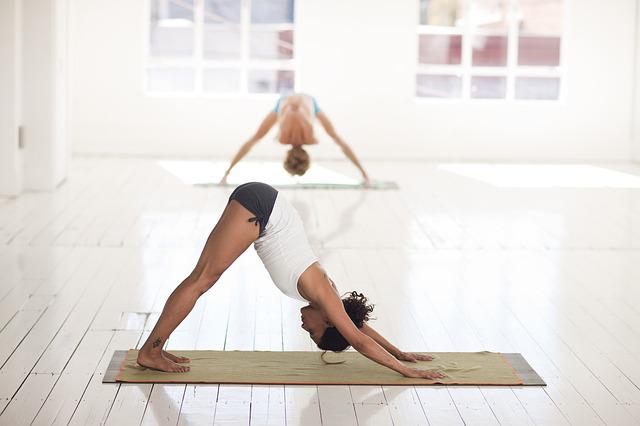
Yoga Is Modifiable
Many people are reluctant to leave their comfort zones and try new things. When they usually feel comfortable taking on physical challenges, they might be afraid they can’t do the poses, won’t be able to follow along, or will feel incompetent. But yoga isn’t designed to fit everyone’s needs. The method is actually very adaptable.
Yoga poses and sequences can be altered to suit your body, skill level, and needs if they seem difficult to you. Yoga instructors frequently offer adjustments for more difficult poses to make them more approachable.
“Listening to my body, moving at my own pace, and letting go of judgment and criticism, both of myself and others, are some of the most important lessons I’ve learned through yoga,” says Kirkpatrick-Thornton. “Plus, there are a variety of positions and modifications for poses that allow for individual differences and ability levels.”
If You’re Pregnant: You Can Do Yoga
Yoga is regarded as a safe and low-impact exercise for expectant parents, as long as you practice safely, even though it can feel difficult at times. Exercise is good for a healthy pregnancy.
“Yoga is safe to practice during pregnancy, but you should exercise caution, advises Simone Tucker, MS, a UMHB exercise and sport science instructor with 200 RYT hours. “During pregnancy, and to a lesser extent during menstruation, the body produces the hormone relaxin. The purpose of relaxin is to loosen up your muscles, connective tissue, and joints to get your body ready for delivery. While this leads to a greater range of motion, it also makes it easier for expecting [parents] to overreach during yoga practice, possibly leading to injury.”
Tucker emphasizes that more experienced yogis should listen closely to their bodies and stay within their pre-pregnancy limits during each practice. Because they might not be aware of their limits, new yogis should be more proactive about safety. Tucker says they should work with a qualified yoga instructor and attend specific prenatal yoga classes.
Don’t Need Expensive Tools & Apparel To Do Yoga
Sure, you can spend hundreds (or even thousands of dollars) at lululemon to stock up on name-brand yoga clothing, equipment, and accessories, but there is absolutely no need to go broke in order to begin a practice.
“Yoga does not require you to dress or look a certain way. The founder of Alt-Yoga Vibe and 200-hour RYT Val Minos says, “That’s absurd. “Yoga is not about how you look; it’s about connecting with yourself more deeply and moving the breath through the body.”
You can do that while wearing whatever you want, whether it’s cozy pajamas or the athletic attire you already own. There is also usually nothing you need to buy before your first yoga class because most studios have mats you can borrow and props you can rent.
You Don’t Have To Feel Self-conscious In Class
In a classroom full of other students, you’re not alone if sticking your glutes up in the air makes you feel a little awkward. “Calli De La Haye, a co-founder of Kalimukti Yoga and a 500-hour RYT, says that students frequently express their fear of the classroom environment because they don’t want to be “watched.” “I wish they were aware that the majority of practitioners are often in the ‘zone,’ so absorbed are they in their own thoughts and activities that they hardly notice anything going on around them.”
While performing some poses, you might feel self-conscious, but if you’re concentrating on your breathing and trying to achieve perfect alignment, you won’t have time to consider your surroundings. And that should tell you something—if you’re too engrossed to check out the rear ends of your fellow yogis, then they’re too engrossed to check out yours.
Yoga Is Gender-inclusive
It shouldn’t come as a surprise to learn that women are more likely to attend yoga classes than men. The advantages of this practice can still be enjoyed by men, despite this.
“I’ve never seen a ‘No Boys Allowed’ sign on a studio door,” says DiNardo. “In actuality, men were the first to practice yoga. Historically, some of the greatest yoga teachers have been men.” LeBron James, Evan Longoria, and Tom Brady are just a few of the many men who practice yoga today.
Practice For A Good Reason
Yes, yoga can increase your flexibility, but you have to put the work in, according to certified yoga instructor Amy Stephens. You might get a good night’s sleep and sore muscles from an occasional class, but you won’t necessarily become more flexible in the long run.
“People think they need to be flexible because they observe the results of years of practice when they observe the teacher moving easily through the class or when they observe yogis on social media performing intricate, highly advanced poses, observes Weible. “They don’t see the struggle and journey those yogis had from their first time on the mat to what they are seeing.”
While everyone’s definition of flexibility will vary, yoga will unquestionably aid in the long run. Katy Brandt of Lotus Blooming Yoga suggests practice and patience. The student’s strength, balance, and flexibility will all increase as a result of this.” According to one study, participating in even one class per week can improve hamstring and spine flexibility. A consistent workout program might also aid in injury prevention.
Embrace Your Body Build
You might see other people doing a particular yoga pose and think, “I want to do that.” While regular yoga practice can undoubtedly lead to an increase in flexibility over time, your body structure will, in part, determine your limits.
“Brandt warns that due to the abundance of pictures of people performing difficult yoga poses, many people think you need to be flexible. “Some people can strike those poses because they have proportionate limbs and a natural flexibility. Some people are more flexible than others, so they might not be able to strike the most difficult poses.”
If you combine flexibility with strength and stability, you can still achieve one of your fitness objectives. Aim for greater range of motion, for instance, if your muscles are tight. Prioritize developing endurance as well if you have a naturally flexible body.
Yoga Involves More Than Just Touching Your Toes
It’s common to picture someone performing a posture that calls for extreme flexibility, such as putting your feet behind your head. But it goes far beyond that. Numerous benefits of yoga include stress reduction, learning to listen to your body, and mindfulness.
“According to Chase, each pose causes your body to sink, greatly lengthening your muscles and releasing your tension. “Though not as long as you might think, it does take time. It’s just a matter of connecting your body and mind. Start with a beginner’s class, and as you gain strength, move on to a class that is more difficult. There are all types of yoga, though. See which form “speaks” to you the most by trying them all at various studios.”
The Bottom Line
So, if you’re not flexible, can you still practice yoga?
One of the most popular yoga myths is the belief that you need to be flexible before ever setting foot on a mat. The fact is that flexibility is not a requirement. In fact, practicing yoga on a regular basis will help you get more flexible over time. Ignore the bizarre pretzel poses you see on social media and instead learn how yoga can improve your mental and emotional well-being.
Have a try!
Regarding your reading, thank you.

